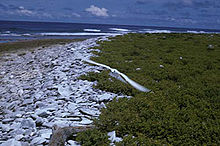- McKean Island
-
"Drummond's Island" redirects here. For other uses, see Tabiteuea.Main articles: Kiribati and Phoenix Islands
McKean Island is a small, uninhabited island in the Phoenix Islands, Republic of Kiribati. It is located at 3°36′S 174°07′W / 3.6°S 174.117°W. Its area is 57 hectares.
Contents
Flora and fauna
McKean is roughly oval in shape, and less than one kilometre in diameter. It is ringed by a reef flat, with a beach ridge of coral rock and rubble surrounding the rim, rising to five metres above sea level. The centre of the island is depressed, with a shallow, hypersaline, guano-laced lagoon. Treeless, McKean harbours seven herbaceous species of plants, and the world's largest nesting population of lesser frigatebird (Fregata ariel) with up to 85,000 birds. 29 other species of birds have been described as visiting the island. Historically, the only mammal is the Polynesian rat, now exterminated, which suggests pre-historic discovery by Polynesians. There is also a species of gecko that inhabits the island.
McKean has no fresh water, and no fresh water lens.
History
McKean Island was the first of the Phoenix group to be reported and named. It was discovered May 28, 1794 by the British Capt. Henry Barber, of the ship Arthur, while en route from Botany Bay, New South Wales to the northwest coast of America.[1] Sighting the uninhabited island on 28 May, Captain Barber named it "Drummond's Island", plotting it at 3°40'S, 176°51'W.[2] The Albany Sentinel reported that the "small sandy island...is very low and cannot be seen from the deck of a vessel more than five or six miles".[3] It was later renamed 'Arthur Island' and appeared as such in charts of that time. Its coordinates were given as 3°30'S, 176°0'W.[4]
The island was reported and visited by a number of ships in the years following, including the whaler Japan in 1830 (under Capt. Shubael Chase), Captain Worth (1832) who mistook it for Onotoa and an unknown whaler in 1834, who named it "Wigram's Island".[5]
It was renamed and mapped by Commander Charles Wilkes of the US Exploring Expedition on August 19, 1840 after a member of his crew. However, Arthur Island remained suspected and "in need of confirmation" until at least 1871, when it was listed in Findlay's Directory, using the charts of cartographer John Arrowsmith.[4]
McKean was claimed by the U.S. in March 1859, under the American Guano Act of 1856, though it was later included in the British Gilbert and Ellice Islands colony. Guano was actively dug and exported from 1859 to 1870. The island was rarely visited after that time. The U.K. resigned its claims on the island when it granted independence to the Republic of Kiribati, and the U.S. resigned its claims to Kiribati in the Treaty of Tarawa.
The island was declared a bird sanctuary in June 1938, and has been a protected area ever since. In addition to natural history expeditions, it was visited in October 1989 by TIGHAR when it was surveyed as a possible landing site of Amelia Earhart.
In 2008, Kiribati proclaimed it to be part of the Phoenix Islands Protected Area, the largest marine protected area in the world. In 2010, the Phoenix Islands Protected Area became the world's largest UNESCO World Heritage Site. In 2002, the wreck of the fishing trawler Chance on McKean released quantities of the Asian rat onto the island, which decimated the native populations of storm-petrels, blue noddies and other petrels and shearwaters.[6] A scientific expedition to eradicate the rats and other invasive species from McKean was recently announced.[7]
References
- ^ Quanchi & Robson, p 11.
- ^ Maude, p 109.
- ^ The Albany Sentinel, 28.8.1797, quoted in Maude, p 109.
- ^ a b Sharp, p 210.
- ^ Maude, p 110.
- ^ http://www.phoenixislands.org/species.html.
- ^ http://www.phoenixislands.org/index.php.
Sources
- Maude, HE: Of islands and men: studies in Pacific history. Melbourne [u.a.] : Oxford Univ. Pr., 1968
- Quanchi, Max & Robson, John, (2005); Historical Dictionary of the Discovery and Exploration of the Pacific Islands, USA: Scarecrow Press, ISBN 0810853957
- Sharp, Andrew (1960); The Discovery of the Pacific Islands, Oxford:Oxford University Press,
- Bryan, Edwin H.: American Polnesia and the Hawaiian Chain. Honolulu., Hawaii: Tongg Publishing Company, 1941 pages 66–69.
Sources: United Nations United Nations Environment Programme TIGHAR TIGHAR
External links
Kiribati Gilbert Islands 
Phoenix Islands Abariringa · Birnie Island · Enderbury Island · Manra Island · McKean Island · Nikumaroro · Orona · Rawaki IslandLine Islands West of Gilberts Reefs Categories:- Phoenix Islands
- Uninhabited islands of Kiribati
- Islands claimed under the Guano Islands Act
- Former populated places in Oceania
Wikimedia Foundation. 2010.


